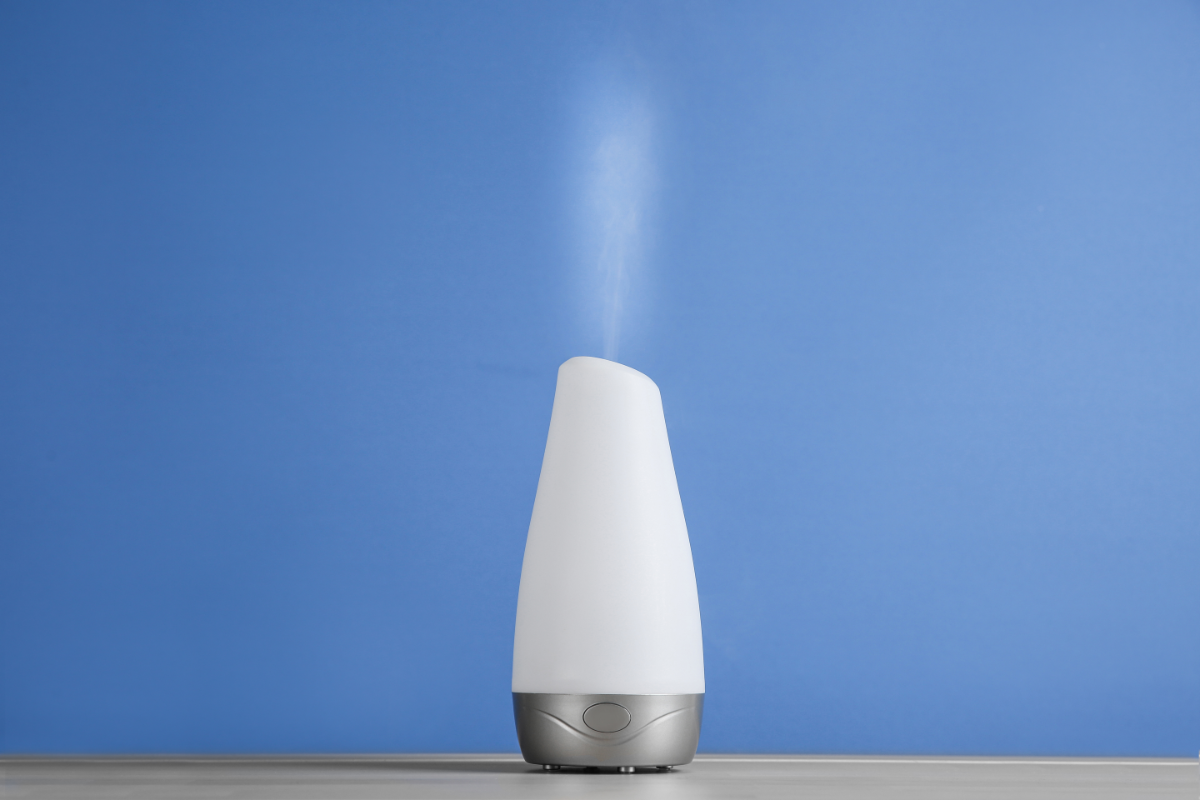Pregnancy is a time to be cautious, especially when it comes to using essential oils (EO) for diffusion. This article looks at the EOs suitable for pregnant women, while addressing the safety aspects and necessary precautions. We explore the benefits of EOs for maternal well-being, highlighting their impact on stress management, improved sleep and the relief of pregnancy-related ailments, while also highlighting which oils are prohibited during this sensitive period. The importance of informed and safe use is paramount in guaranteeing the well-being of both mother and baby.
Reproductive toxicity of essential oils and their constituents
This section is based on a review focusing on the effects of certain essential oils (EOs) and their constituents on the female reproductive system during pregnancy and foetal development. The main concerns are abortion, modulation of reproductive hormones, maternal toxicity, teratogenicity and embryo-fetotoxicity.
Potential effects of specific constituents of EOs
- Anethole, Apiol, Citral, Camphor, Thymoquinone, Trans-Sabinyl Acetate, Methyl Salicylate, Thujone, Pulegone, β-Elemene, β-Eudesmol, and Costus Lactone: These components of EOs have been studied for their effects on the reproductive system. Although some plants may improve female reproductive function, the use of EOs during pregnancy remains controversial due to these potential risks.
- Potential toxicity: Major concerns include induction of abortion, modulation of reproductive hormones, maternal toxicity, teratogenicity and embryo-fetotoxicity. Studies have shown that these constituents can cross the placental barrier, potentially affecting foetal development.
Recommendations based on studies
- Cautious use: Due to these risks, it is recommended to avoid or restrict the use of EO containing these specific constituents during pregnancy and breastfeeding.
- Variability of effects: The toxicity of these constituents may vary depending on the dose and route of exposure. For example, although certain components such as citral are present in many everyday products, their consumption in high doses during pregnancy could be a cause for concern.
- Differentiating effects: It is important to differentiate the activities of whole EOs from those of their isolated constituents, as EOs are complex mixtures and their effects can differ considerably from those of their individual components.
In conclusion, although EOs have many recognised health benefits, their use during pregnancy must be carefully evaluated. Healthcare professionals and pregnant women need to be aware of these potential risks in order to make informed choices about the use of EOs.
The benefits of diffusing essential oils for pregnant women
-
Stress management and relaxation
Stress and anxiety are common during pregnancy and can have an impact on the health of both mother and foetus. Studies, such as that conducted by Field et al (2005) and published in the Journal of Psychosomatic Obstetrics & Gynecology, have shown that aromatherapy, particularly with lavender essential oil, can significantly reduce stress levels. The study highlighted how inhaling lavender helps to reduce the stress hormone cortisol, offering a natural means of relaxation for pregnant women.
-
Improved sleep
Sleep, often disturbed during pregnancy, is essential to a mother’s health. A study by Chang and Chen (2011) published in the Journal of Nursing Scholarship explored the effect of aromatherapy with lavender essential oil on the quality of sleep in postpartum women. Although the study focused on the post-partum period, its results suggest that lavender oil could also be beneficial for improving sleep quality during pregnancy.
-
Relief of common pregnancy ailments
Essential oils can also offer natural relief for certain pregnancy aches and pains. A study published in the Journal of Obstetrics and Gynaecology by Burns et al (2000 ) examined the effect of aromatherapy in relieving nausea and vomiting during pregnancy. They found that certain oils, such as ginger, can be effective in reducing these symptoms, offering a natural alternative to drug treatments.
These studies highlight the potential of essential oils as complementary tools for managing stress, improving sleep and relieving some of the discomforts of pregnancy. However, it is crucial to consult a health professional before using them to ensure that they are suitable for your particular situation.
Precautions to take when diffusing essential oils
Essential oils, although beneficial, can present risks, particularly due to the presence of phenols,aromatic aldehydes and ketones. These compounds have specific characteristics and biological effects which, if misused, can be harmful.
Phenols, present in certain essential oils, are known for their powerful antibacterial and antifungal properties. However, they can also be irritating to the skin and mucous membranes, raising concerns about their use without adequate precautions. Similarly, aromatic aldehydes, although they have antibacterial and antifungal properties similar to phenols, can also be irritating and toxic if overexposed or misused.
Ketones, another group of compounds found in some essential oils, can be neurotoxic if used in excess. Their potential toxicity is a major concern, particularly in the context of atmospheric dispersion where it can be difficult to control concentration and exposure.
It is therefore crucial to understand and respect the specific characteristics of each essential oil, to follow the recommendations of health professionals, and to use these substances in an informed and safe manner to avoid any potential risks. The use of essential oils, especially those containing phenols, aromatic aldehydes and ketones, must be done with caution and a thorough knowledge of their properties and possible undesirable effects.
The best essential oils for pregnancy
Pregnant women: Essential oils authorised for diffusion
It’s essential for pregnant women to know which essential oils are safe for pure diffusion. These oils, chosen for their gentle and beneficial properties, can contribute to well-being during pregnancy, while minimising the risks. Here is a list of essential oils authorised for pure diffusion for pregnant women:
- Bergamot: Soothing and balancing, ideal for reducing stress.
- Bergamot without Bergaptene: A safer version of the classic bergamot.
- Roman Chamomile: Calming and relaxing, perfect for improving sleep.
- Cardamom: Comforting and aids digestion.
- Cistus: Soothing and restorative properties.
- Lemon: Refreshing and purifying, excellent for the mood.
- Java citronella: Relaxing and insect repellent.
- Cypress of Provence: Good for circulation, with a calming effect.
- Frankincense: Ideal for meditation and deep relaxation.
- Black Spruce: Invigorating and purifying.
- Tarragon: Soothing, particularly for digestive comfort.
- Lemon Eucalyptus: Refreshing and soothing for the respiratory tract.
- Rose Geranium: Balancing, ideal for mood and skin.
- Ginger: Comforting and aids digestion.
- Noble Laurel: Stimulating but gentle, promotes self-confidence.
- Lavender Aspic, Fine Lavender, True Lavender, Lavandin Super: Relaxing and soothing, ideal for sleep and stress.
- Lemongrass: Invigorating and refreshing.
- Green Mandarin: Calming and cheerful, perfect for the mood.
- Marjoram: Relaxing, helps relieve stress and anxiety.
- Lemon balm: Extremely soothing and relaxing.
- Red Myrtle, Green Myrtle: Purifying and gentle on the respiratory tract.
- Niaouli: Clears the mind and helps breathing.
- Sweet Orange: Soothing and mood-enhancing.
- Grapefruit: Fresh and energising, ideal for stimulating the mind.
- Petit Grain Bigarade: Calming and mood-balancing.
- Hemlock: Soothing, helps you relax.
- Ravintsara: Stimulates immunity, yet is gentle.
- Rosemary Cineole: Invigorating without being too stimulating.
- Balsam Fir, Siberian Fir: Purifying and invigorating.
- Saro: Fortifies the immune system and soothes.
- Tea Tree: Purifying and immune-boosting, without being too strong.
- Thujanol Thyme: Gentle and beneficial for the immune system.
It is important to note that even essential oils considered safe should be used with caution. It is advisable to consult a health professional or certified aromatherapist before beginning any use of essential oils for diffusion during pregnancy.
Essential oils for diffusion are prohibited for pregnant women
Pregnant women should be cautious about using essential oils, particularly as a vapour. Some oils, because of their specific properties, are not recommended during pregnancy. Here is an exhaustive list of essential oils that should not be diffused by pregnant women:
- Wild Chamomile: Known for its stimulating properties, it may be too strong for a pregnant woman.
- Caraway: This oil is known for its effect on the digestive system but can be irritating during pregnancy.
- Chamomile Matricaria: Although beneficial in other contexts, it should not be diffused during pregnancy.
- Atlas Cedar: Its powerful circulatory properties make it an oil to be avoided.
- Combava: This oil may be too stimulating for pregnant women.
- Coriander Seed: Potentially disruptive to hormonal balance.
- Clove: Very strong, it is not recommended due to its anaesthetic properties.
- Sea Fennel: May interact with hormones and the immune system.
- Eucalyptus Globulus: Too intense for use during pregnancy.
- Galbanum: May have stimulating and disruptive effects.
- Juniper: Potentially harmful due to its diuretic properties.
- Helichrysum of Madagascar: Avoid due to its effects on circulation.
- Khella: May affect the cardiovascular system.
- Lentisque Pistachier: Known for its effects on circulation, it should be excluded.
- Lovage: May be too stimulating for pregnant women.
- Marjoram: Potentially irritating and disturbing.
- Field Mint, Spearmint: Too strong and potentially irritating.
- Nutmeg: Its psychoactive effects make it inappropriate.
- Myrrh: Can be too strong and affect the immune system.
- Lemon Myrtle, Palmarosa: Potentially irritating.
- Douglas fir, Black pepper: May be too stimulating.
- Rosemary camphor, Rosemary verbenone: Their properties are too powerful for pregnancy.
- White fir, Mountain savory: May affect blood pressure.
- Clary sage, Lavender leaf sage: Hormonally active, they should be avoided.
- Annual tansy, Goldenrod: May be too stimulating or disruptive.
Are essential oils toxic for the placenta?
The study entitled “Evaluation of Placental Toxicity of Five Essential Oils and Their Potential Endocrine-Disrupting Effects” offers crucial insights into the interactions between essential oils (EOs) and the placenta. The main objective was to assess the placental toxicity of five commonly used EOs – niaouli, orange, tea tree, ylang-ylang and wintergreen – and their potential endocrine-disrupting effects.
A major finding of this study is that these EOs appear to act more as hormone modulators than as endocrine disruptors in human placental cells. Contrary to what might have been feared, these EOs did not activate the P2X7 receptor, which is associated with cell death. This indicates that, although they may alter certain hormones, they do not cause undesirable cellular effects in this study.
The study also highlights the complexity of EOs, which are composed of numerous chemical products that vary in structure and composition. For example, an EO can contain more than 150 different substances. This complexity makes it difficult to predict their endocrine disrupting potential based solely on safety data relating to one of their components, even the main one.
Hormone modulators or endocrine disruptors?
In addition, the study examined the effect of key components of these EOs (such as 1,8-cineole for niaouli or limonene for orange) on the release of certain hormones and the activation of the P2X7 receptor in JEG-Tox human placental cells. The results indicate that the hormonal effects observed with these key components differ significantly from those observed with complete EOs.
It is also important to emphasise the need to differentiate between endocrine disruptors and hormone modulators, the latter being potentially less dangerous. Indeed, many EO components are present in everyday products without necessarily causing endocrine disruption.
In conclusion, this study is the first to explore the placental toxicity of EOs. Although some EOs disrupted at least one hormone studied, the lack of activation of the P2X7 receptor leads to the conclusion that these EOs are more likely to be hormone modulators rather than endocrine disruptors. However, further studies, particularly in vitro, are needed to confirm these results and assess other potential health effects at cellular level.
Source:
- 13 January 2021. A pilot study on essential oil aroma stimulation for enhancing slow-wave EEG in sleeping brain
- Food Sci Nutr. 2019 Jan 25;7(2):369-384. doi: 10.1002/fsn3.903. eCollection 2019 Feb.
Efficacy of bergamot: From anti-inflammatory and anti-oxidative mechanisms to clinical applications as preventive agent for cardiovascular morbidity, skin diseases, and mood alterations - Int J Mol Sci. 2021 May 3;22(9):4844. doi: 10.3390/ijms22094844. Therapeutic Effect and Mechanisms of Essential Oils in Mood Disorders: Interaction between the Nervous and Respiratory Systems
- Published: 15 August 2017. The antibacterial and antifungal activity of six essential oils and their cyto/genotoxicity to human HEL 12469 cells
- Treating yourself with essential oils. Why and how do they work? Editions du Rocher.
- Curr Issues Mol Biol. 2022 Jul; 44(7): 2794-2810.Published online 2022 Jun 28. Evaluation of Placental Toxicity of Five Essential Oils and Their Potential Endocrine-Disrupting Effects
- Int J Mol Sci. 2021 Mar; 22(5): 2380. Maternal Reproductive Toxicity of Some Essential Oils and Their Constituents





